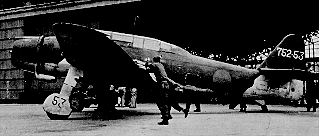
Aichi B7A Ryusei, (Scanned from René J. Francillion "Japanese Aircraft of the Pacific War" - Putnam - 1979),
got from the Imperial Japanese Navy Page
The need of a heavy Torpedo-/Dive bomber for use on a new big aircraft carrier class was the reason
for the 1941 demand of the imperial japanese navy for a sircraft type which should succeed the Nakajima B6N
and Yokosuka D4Y. An internal bomb storage of 500kg or a 800kg torpedo, high maximum speed and great
range were the demands the navy made. This made a very stron powerplant necessary, and the japanese navy
risked the use of the Homare 11, which was still in the testing stadium.
After the first flight of the prototype B7A1, many designing problems had to be solved until th model B7A2 went
in may,1944 into quantity production. Unfortunately (for the japanese navy), the assembly line was destroyed
during an earthquake in May, 1945 after the production of 80 airplanes, but 25 more were built at Omura in a
navy aviation arsenal. This makes 114 at all, because there were 9 prototypes.
When this model entered sevice with the japanese navy, there were no big aircraft carriers left, and operating
from runways their effect was very small. Ryusei means "Shooting Star", the allied codename was "Grace" and
the allocated units were the 752nd and Yokosuka Kokutais.
My comment:
This was the best torpedo-/dive bomber which entered service within WW2, and it would have played an
important role if the war wasn´t lost yet for Japan. In combination with a naval fighter which would have to be
a worthy opponent for F4U and F6F, the results would have been nearly as devastating as in the early pacific
war. But it came too late, the D4Y hadn´t enough armour and B6N hadn´t enough speed to keep the pressure
up (and IJN carriers alive) until the B7A appeared.
A rival was the british Fairey Spearfish [yes, Fairey finally managed to build a modern plane!]. The Spearfish
was 100km/h slower, unable to dive and had a lower range, but it had advantages; a retractable ASV radar and
remotely controlled defensive armament (2 single 0,5" M2 MG, looking like the Me210/410 armament). The
Spearfish was only built as prototypes (1 in ´45 and 2 in ´47) because interest in turbo planes grew.
An error, as the Skyraider later told us. I believe that from 1943 on, directional radio guided bombs were able
to replace dive attacks, so dive breaks/capability were only useful for precise ground attacks.
| Specifications: | |
|---|---|
| Aichi B7A2 Ryusei japanese torpedo-/dive bomber | |
| Dimensions: | |
| Wing span: | |
| Length: | 11,49m |
| Height: | 4,08m |
| Weights: | |
| Empty: | 3.810 |
| Maximum Take-Off: | 5.625kg |
| Performance: | |
| Maximum Speed: | 565km/h at 6.550m |
| Service Ceiling: | 11.250km |
| Normal Range: | 3.040km |
| Powerplant: | |
| 1.825PS Nakajima NK9C Homare12 18cylinder air-cooled radial | |
| Armament: | |
|
one 800kg torpedo or up to 800kg bombs, two wing-mounted 20mm cannons and one rear-firing 7,92mm or 13mm MG | |
a captured B7A with folded wings